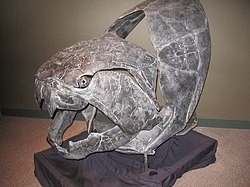Gnathostome
| Jawed vertebrates Temporal range: Middle Ordovician – Present, 462–0 Ma |
|
|---|---|
 |
|
| The placoderm Dunkleosteus, an early jawed vertebrate |
|
| Scientific classification | |
| Kingdom: | Animalia |
| Phylum: | Chordata |
| Subphylum: | Vertebrata |
| Infraphylum: | Gnathostomata |
| Subgroups | |
|
|
Gnathostomata /ˌneɪθoʊstoʊˈmɑːtə/ are the jawed vertebrates. The term derives from Greek: γνάθος (gnathos) "jaw" + στόμα (stoma) "mouth". Gnathostome diversity comprises roughly 60,000 species, which accounts for 99% of all living vertebrates. In addition to opposing jaws, living gnathostomes also have teeth, paired appendages, and a horizontal semicircular canal of the inner ear, along with physiological and cellular anatomical characters such as the myelin sheathes of neurons. Another is an adaptive immune system that uses V(D)J recombination to create antigen recognition sites, rather than using genetic recombination in the variable lymphocyte receptor gene.
It is now assumed that Gnathostomata evolved from ancestors that already possessed a pair of both pectoral and pelvic fins. In addition to this, some placoderms were also shown to have a third pair of paired appendages, that in males had been modified to claspers and basal plates in females, a pattern not seen in any other vertebrate group.
The Osteostraci are generally considered the sister taxon of Gnathostomata.
It is believed that the jaws evolved from anterior gill support arches that had acquired a new role, being modified to pump water over the gills by opening and closing the mouth more effectively – the buccal pump mechanism. The mouth could then grow bigger and wider, making it possible to capture larger prey. This close and open mechanism would, with time, become stronger and tougher, being transformed into real jaws.
...
Wikipedia
